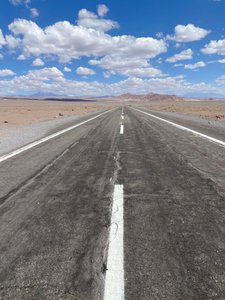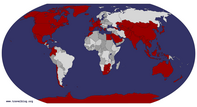Advertisement
Published: February 20th 2023

 Following that Road
Following that Road
around the world... seeking adventure and understanding.There are those of us who prefer the verdant greens, the lush vegetation, abundant colorful flowers, and a plethora of animal life. While we have come to enjoy these types of venues, we also love to admire the desolate, bleak, stark and wind-swept environs of the desert. This seemingly inhospitable environment possesses its own beauty but displays it differently. Sunrise and sunset are particularly enjoyable.
Now, this is one dry desert. Wait….what does that mean? Well, technically by definition a desert is an area of land that receives less than 10 inches (25cm) of rain per year. Pretty dry, yeah? Well, the Atacama is the second driest desert in the world, bested only by a patch of land in Antarctica. The Atacama Desert is the result of the actions of the Humboldt Current off the coast and the position of the land in between the Andes and the Chilean Coast Range mountains which are tall enough to literally shut out moisture by creating a two-sided rain shadow. Anecdotally, we were told of an area of this desert that had not seen rain in over 29,000 years. In other words, seriously

 We love Flamingos!
We love Flamingos!
Nice reflection. Dave did a great job!dry. There is so little precipitation so that over time the surface has built up a crusty layer of salts, which only further discourages life.
We went because we’ve read and heard about the beauty of the desert and certainly were not disappointed. A two-hour flight from Santiago to Calama and then a one-hour transfer will find you in San Pedro de Atacama, the jumping off point for many desert adventures. Calama is an interesting place as it is the center of mining for Chile, which is the world’s largest producer of copper and the second largest producer of lithium. The whole city is built around mining and people come from far away to work here. With so little to do outside of work, you can guess that imbibing in alcohol and seeking women of the night are large industries. Calama was much larger city than we were expecting. The money to be made working in the mines draws people from all over the country to come here. Enterprising people have built several casinos to provide entertainment. It makes you wonder how much of all that hard earned money makes it back home to the family?
Along this
highway, we saw several memorials to people who had died on these roads. Our driver told us many of the were long haul drivers going too fast. This highway which is decent allows truckers to take goods all the way to Brazil. We asked if you can drive from Santiago and we were told it takes about 23 hours. The road is closer to the coast to avoid some of the high mountains and to prevent driving through some of the desert. He tells us there is one stretch with nothing... for 5 hours of your drive there is only one gas station... and nothing else. That is one lonely road and we're glad we took the two hour flight.
As we drove into town, we passed some amazing rust colored rock formations. Our driver explained these mountains are called the Salt Mountains. They are made of clay but have an extremely high salt content which gives them an interesting and unique reddish color.
Evidentally, the Atacama Desert has similar qualities to Mars including soil and over the years NASA has been out here doing research, testing and preparation to Mars. One area of rock formations is referred

 A Geologist's Happy Place
A Geologist's Happy Place
Atacama Desert Valley of the Moonto as Mars, although we don’t think that is how they spell it.
Due to the stark landscape many movies have been filmed out here including Star Wars and 2001: A Space Odyssey.
Copiapo Copper Mining Accident You may have read the articles or seen movies about the Copiapo Copper Mining Accident where the 33 miners were trapped and survived 69 days. The Atacama Desert is where all of that took place.
San Pedro de Atacama San Pedro de Atacama is a dusty little town in an oasis with dirt roads. It has restaurants, bars and adventure shops as its base of business. Tourists come and go with great frequency so at times of the day it is rather lively. The buildings are one story squared off adobe looking and reminded us of buildings you might see in an old western. If you are looking for any outdoor adventure in the desert, you will find it here.
Our three days were filled with great adventures. On our first day, we drove into the Valle De la Luna (Valley of the Moon) where the great salt domes had formed. Pictures do not really do this
area justice. These areas were once mined for salt up until about 1960, when less expensive techniques were employed, and signaling the end of desert salt mining. We then hiked to the top of the Gran Duna (Great Dune) to take in an impressive panorama of the surrounding valleys and peaks, sculpted by the winds over time. Another stop found us looking at interesting rock formation called The Three Mary’s. Our day ended with pisco sours, snacks, set up next to our vehicle and a sunset over the valley. A few days before our arrival they had a half day of rain, evidentially it was hard rain and flooded the streets. Due to this fortunate event while we were there, we saw a stunning top layer on the clay of dried salt from the recent water. It made it look like snow. Our guide said it was unusual for us to see it like this.
The following day found us on an all-day excursion which included traversing vast expanses of salt flats. The flats are the world’s third largest and contain a fair number of flamingos. We were expecting many more than we saw but were told that there
had been a severe reduction in egg-laying over the past four years. In this area in recent years, they have taken on several water projects and this has messed with the happiness of the flamingos and not one egg has been laid in four years. They are attempting to figure out how to fix the problem the companies have caused. The Chilean flamingos are not as colorful, as their Floridian cousins, most of them are white, but are beautiful, nonetheless. A hike to Laguna Miscanti revealed brilliant azure colored water set among a gorgeous valley. Once again, pictures really do not reveal the amazing beauty of this setting. Mountains surround all of these areas so it makes for beautiful backdrops no matte where you explore.
The next day had us up at a painfully early hour (pick up at 430am) to drive up to about 13,000 feet to take a look at the highest elevation of geothermic geysers. We were told to dress warmly, but we’ve just been in Florida too long and despite multiple layers of clothing and a jacket, we were no match for the 20 degree (-5) temperatures that awaited us. Our only saving grace was
that there was no wind that morning or it could have been much more painful. The geysers were just so-so to us as we’re spoiled in the U.S. with “Old Faithful” in Yellowstone National Park. We’ve also seen nice geysers in Iceland and New Zealand and these do not compare. We’d like to confess as we were walking along looking at these geysers we were freezing our butts off and still grumbling a bit about the need to get up so early… we decided we may have seen enough geysers in our life. It was so cold... how cold was it... that the desert grasses with frozen and had ice crystals forming. Please see the photos. The future will tell the story. The saving grace with these is they are supposed to be at the highest elevation of all geysers. We moved to a scenic viewpoint where we could still see the smoke from the geysers and our guide and driver fixed us scramble eggs, cheese, fresh guacamole, cookies, coffee and other foods, and that allowed us to enjoy the early morning sun wafting over the mountain peaks, highlighting the steam thrown off by the geysers. It was at least

 Crystal Formation
Crystal Formation
Valley of the Moon25 degrees warmer in this location, so we were extremely happy. Ok, so we are whining a bit, but Florida life has thinned out our blood … and we didn’t have all the cold weather gear we needed which is on us. In our defense, on a six-week trip packing is tricky and you do the best you can.
Cute story… they pronounce geysers, “geezers,” so we chuckled every time they said it. We made jokes about geezers going to see the geezers.
We had a great photo stop at the Tropic of Capricorn. Everyone enjoyed taking pictures.
In our time here we saw mountains, amazing geological formations, volcanos a plenty, salt flats, a marsh, marsh birds, flamingos, geysers, a lot of open space, other local animals like ostrich and vicuna.
That evening, we were supposed to do some desert star gazing with guides and telescopes, but it was cancelled due to cloudy skies. It was disappointing as there is so little light pollution in this area of the world that the stars are incredibly bright, not to mention that we can see stars not visible in the northern hemisphere. It would have been a great
experience.
All our guides, wait staff, and locals we spoke with love living out here. Several we spoke to moved from various parts of the country to work, they fell in love with it and have stayed 6, 8, 10 years and have no plan to leave. It wouldn't be a place I would pick to live but seeing the joy this location brought them was renewing. It is good that everyone doesn't want to live in the same place.
Where we stayed: Hotel Kimal (they offer a spa with massages!)
Restaurants recommended: La Casona (has good live music as well) and The Adobe
Emporio Andino. - we are told the best empanadas in town... yes, they were good.
Advertisement
Tot: 0.098s; Tpl: 0.017s; cc: 18; qc: 35; dbt: 0.0554s; 1; m:domysql w:travelblog (10.17.0.13); sld: 1;
; mem: 1.2mb


































Claudia
non-member comment
Chilled Geezers
Those skies look amazingly blue! Know you missed that star gazing- it was intense in the Sahara when we traveled to the Sahrawi camps. Hope you two are fully thawed and ready for more travel.